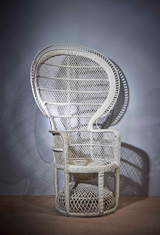STRUCTURAL FEATURES: The actual origin of this chair is quite debatable -- though the form would then manifest as the Southeast Asian rattan hourglass chair displayed during the Philippines Centennial Exhibition in 1876. The flared, high-arched back of this tall, statuesque chair evokes the canopy-like structure of the 17th-century Mayurasana (or Peacock Throne) used by Emperor Shah Jahan. It is christened the ‘hourglass chair’, owing to the eponymous shape of its base, which also alludes to that of the damroo. Made out of cane, a popular material used to craft furniture at various places in India such as Silchar in Assam and Vellore in Tamil Nadu, the chair is intricately woven, has a round cushioned seat and is ideal as patio furniture.
STYLISTIC FEATURES: The fantail-back is elaborately woven in a jali-like pattern, similar to the latticed architectural element of monuments built during the Indo-Islamic period. Later on, numerous descendants of the peacock chair would emerge – those with a coat of brightly-coloured paint; or rendered in wrought iron; or gold-toned metal wire; and American architect and interior designer Frank Lloyd Wright would, in the early 1920s, create a streamlined version using oak and metal.
Courtesy: The Taj Mahal Palace, Mumbai



PEACOCK CHAIR
DESIGNER: Unknown
MATERIAL: Rattan or cane with a cushioned seat
STYLISTIC INFLUENCE: Indo-Islamic
DESIGNER: Unknown
MATERIAL: Rattan or cane with a cushioned seat
STYLISTIC INFLUENCE: Indo-Islamic

